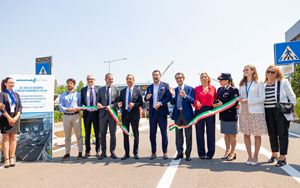(Finance) – Ensuring greater traffic flow by applying innovation and technology to allow for the adaptation of infrastructure capacity, following the principles of sustainability and urban redevelopment. And the project by the Autostrade per l’Italia Group carried on in urban section of the A4 Turin – Trieste and became reality today thanks to the development and application of a sophisticated technological system. “Opened to traffic this morning, the dynamic fourth lane, between lo junction of Cormano and the junction of viale Certosa, in both directions, represents – explains Aspi in a note – a unique response in Italy to the need to increase the capacity of the section despite the impossibility of flooding the motorway carriageway, due to the close proximity to densely populated areas. The Turin-Trieste route is in fact characterized by a high incidence of vehicular transits, with peaks reaching 200,000 vehicles a day, mostly heavy vehicles, also given its location in one of the main industrial centers of the country. In particular, in the urban section of the A4 there is a daily average of transits three times higher than the average recorded in the other assets managed by Autostrade per l’Italia”.
To adapt the stretch to the growing traffic needs, Aspi, through Movyon, catalyst of technological innovation of the Group, has developed a control system capable of managing the transition from three-lane operation plus emergency to four-lane operation. In fact, the platform ensures that the fourth available lane is used and temporarily allocates it to vehicular traffic when specific conditions are detected on the stretch, measured through the processing of data acquired via detection sensors, the use of vehicular flow analysis and forecasting algorithms . The system manages three activities in a coordinated way: analysis, reporting and detection. The traffic analysis system allows you to constantly monitor and analyze the vehicular flow, the signaling system immediately communicates to users in transit the information relating to the change in use of the lanes and speed limits. The automatic incident detection system finally, it detects all events with possible repercussions on the use of the dynamic lane, such as stationary vehicles, wrong-flow vehicles or queues. Monitoring, in line with the technology used in the military aeronautical sector, takes place through the use of radars, laser scanners and video cameras equipped with artificial intelligence algorithms which continuously scan the roadways and vehicular traffic.
The new infrastructure, in addition to guaranteeing a better travel experience, – explains Aspi – generates benefits in terms of environmental impact: for every hour of activation of the fourth dynamic lane on the ten km on which it is envisaged, a saving of around 1.5 tons of CO2 is estimated. The project, also due to its sustainable vocation, is one of the initiatives in the field of ITS (Intelligent Transport Systems) carry on from Group Mercury Program, the large unitary and coordinated pole for technological innovation, developed to guarantee safer infrastructures and to participate as protagonists in the revolution of decarbonisation, digitalisation and the development of new mobility systems. The Program works for the modernization and enhancement of the network in a digital and sustainable way thanks to the synergy between the different companies of the Group: Movyon for technology, Techne for design and engineering, Broaden for the construction of infrastructure, FreeToX for the development of mobility services ed Elgea for the production of energy from renewable sources.
There dynamic fourth lane of the A4 between the Cormano junction and the viale Certosa junction was inaugurated this morning in the presence among others of Matthew Salvini, Minister of Infrastructure and Transport, Attilio Fontanapresident of the Lombardy Region, Joseph Salamayor of Milan and of Roberto Tomasi, CEO of Autostrade per l’Italia.
The A4 upgrading project, developed by the Aspi Group under the supervision of the Ministry of Transport and Infrastructure, it affects the entire section from the Fiorenza interconnection to the Sesto San Giovanni junction for a total investment of over 240 million euros. The upgrading program also includes a series of initiatives for the benefit of the local area, both in terms of reducing noise pollution and for the improvement of city traffic and the roads leading to the motorway system, such as the antiphonic tunnel of Cinisello Balsamo, the upgrading of the Dalmine junction and the reconfiguration of the Sesto San Giovanni junction.
